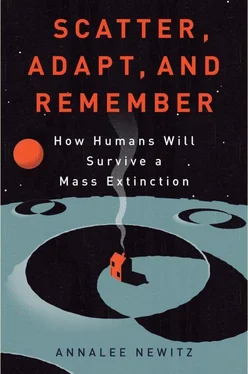Apparently, at the last minute, the Pharaoh changed his mind about the whole deal and tried to send his soldiers after the fleeing Jews. That’s when Moses got superheroic, held out his hand, and parted the Red Sea. If you’ve ever seen Charlton Heston chewing the scenery in The Ten Commandments, you know what happened next. The Jews raced to the other side of the sea, hotly pursued by the Egyptian army. But once they’d reached the far shore, Moses let the waters smash back into their proper place, drowning the army and beginning the first chapter of the diaspora story.
For forty years, according to the Bible, the Jews wandered in the desert of what was then called Canaan, looking for a place to live. That’s when they became a diaspora people, a group far from their ancestral home and searching for a place to live where they wouldn’t be enslaved or worse. Later in the Bible, God leads the Jews to their “promised land,” eventually called Israel, which their children are destined to conquer. But the story of the book of Exodus ends with the Jews still in the desert, having won one battle but facing many more, unsure whether they’ll survive to find a home.
This ending is as significant as the structure of the story itself. It’s oddly realistic, leaving our main characters stranded in the middle of events whose outcome only their children will ever know. It suggests that when we struggle for a better life, we may never reap the benefits of that struggle ourselves. At the same time, the meat of the story is a powerful antidote to ancient tales glorifying war that were written during the same era as Exodus probably was. Stories about how cool it is to rip your enemies’ faces off appear elsewhere in the Bible (the books of Kings and Judges are complete bloodbaths), as well as in cuneiform tablets created by groups in the Assyrian empire and others. During a time in history when most nations celebrated military force and gory battles, the diaspora story in Exodus teaches us that there is great bravery in retreat. It is an act of tremendous strength to choose life and an uncertain future, rather than death in war. For the Jews who internalized this message, rather than the slaughter-is-nifty one, survival became a struggle that was often more difficult than death. But they lived. And so did their children, for generations that spanned millennia.
In modern parlance, the term “diaspora” refers to the geographical dispersion of people who are separated from their homeland. But, as political scientist William Safran explained in the first issue of the scholarly journal Diaspora, it can also refer to the diverse peoples who are the result of such a movement. Many groups have experienced a diaspora, including Africans outside Africa and Asians outside Asia, often due to some kind of major social upheaval. Today, these groups as well as Jews are commonly called diaspora peoples, even though many of them live in the same place that their families have for generations.
The word “diaspora” comes from ancient Greek, where it was first used to describe people who left their homelands to colonize distant regions. Gradually the term was applied to the Israelites of the era of the Babylonian exile, whose experiences were ironically the opposite of the original Greek meaning.
Though the rich geographical detail of the story in Exodus has led many to assume that it’s based on an actual historical event, archaeological excavations over the past few decades suggest that the story captures the spirit of the Israelites, but not their actual historical origins. UC Berkeley archaeologist Carol Redmount studies ancient Egyptian civilizations, and says there’s no evidence that the Jews or even their Asiatic ancestors were in Egypt during the time period described in Exodus—roughly during the reign of Rameses in the late second millennium BCE.
Instead, based on archaeological surveys of the region, it seems likely that the Jews during this time were a nomadic group whose members began to settle in small subsistence communities in the hills near Egypt at the height of the Bronze Age in the 1400s or 1300s BCE. Over the next several hundred years, these groups established many kingdoms, including a thriving northern region called Israel. But then in the eighth century BCE, Israel fell to the Assyrians and the formerly backwater southern kingdom of Judah rose to power. Judah’s biggest city, Jerusalem, once a hick town, became a thriving, walled metropolis hugging the base of the famous Temple Mount. It was also during this period that some archaeologists believe Jewish priests in Judah put the book of Exodus together from several sources.
Still, we don’t find archaeological evidence for a situation comparable to the one described in Exodus until the sixth century BCE. At that point, Judah had been a client state of Babylon for decades, and tensions between the two powers finally reached a breaking point. Judah revolted against the Babylonians and was completely crushed. In 587 BCE, the Babylonian king Nebuchadnezzar II led his troops into Jerusalem and destroyed it. Archaeologists have found sooty traces of a massive fire within the city’s walls from this era, along with countless arrowheads. The burning of the city sent many Jews into exile throughout the region, but within a few generations many returned to Jerusalem and assimilated into Babylonian society, adopting the local language, Aramaic, for writing. Indeed, in Jewish writings of the period, Judah is referred to by the Aramaic name Yehud. It’s also during this era that the nomadic hill people who created the nations of Israel and Judah started calling themselves Yehudim, or Jews.
One might argue that Jewish identity coalesced during a period when its nation was fragmented. And the Babylonian exile was just the first of many great fragmentations recorded in Jewish history. In the first century CE, Jews fled the Romans; in the fifteenth century, they raced to outrun representatives of the Spanish Inquisition; and still later, they abandoned large parts of Europe to escape the twentieth-century Holocaust. Passover has probably remained such an important ritual because it’s designed to remind Jews of our shared history as people who scatter in order to survive. To this day, we dwell in all the far-flung places where Jewish communities large and small continue to tell stories of a legendary time when we clung to life by running as far as we could, in as many directions as we could.
But is scattering really a good survival strategy outside of legends? If Jewish history is any guide, the answer is yes. Despite centuries of persecution and diaspora, there are people all over the world who call themselves Jews. And now we have scientific evidence that today’s Jews haven’t just inherited a cultural tradition. Some of us really do have biological ancestors who survived by wandering in the desert and beyond to find new homes. Population geneticists say there’s strong evidence that a group of Jews originating in ancient Rome over 2,500 years ago share identifiable genetic links with Jewish populations today from Spain, Syria, North Africa, Russia, and many other places. In other words, many Jews today owe their existence to people who scattered.
The Genetic Evidence for the Diaspora
Geneticist Harry Ostrer has contributed to one of the world’s largest and longest-running genetic studies of Jewish people. An energetic and talkative man, he collaborates with colleagues and subjects across the globe from a slightly cluttered office at the Albert Einstein College of Medicine, surrounded by family pictures and lab equipment. Located in a quiet neighborhood in the Bronx, the college is practically in the backyard of some of the groups Ostrer studies, like Brooklyn’s Syrian Jewish community, as well as a few Iraqi Jewish enclaves in Queens. He’s done work with a large group of Turkish Jews in Seattle, too.
Читать дальше






![Аннали Ньюиц - Автономность [litres]](/books/424681/annali-nyuic-avtonomnost-litres-thumb.webp)





